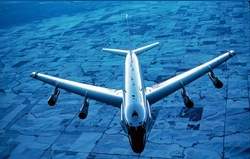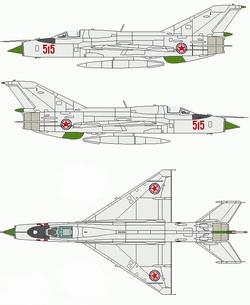Sun, Mar 09, 2003
RC-135 Intercept Was Apparently Bid For Pueblo-Like
Crisis
 It had
all the markings of a cold war-style confrontation. An American
reconnaissance aircraft, patrolling over international waters in
the Sea of Japan, was suddenly beset upon by four North Korean
fighters last weekend. But the New York Times reports it was
actually much more than an attempt at aerial intimidation.
Instead, the North Korean MiGs were trying to force the aircraft to
land in North Korea and seize its crew, the New York Times has
reported.
It had
all the markings of a cold war-style confrontation. An American
reconnaissance aircraft, patrolling over international waters in
the Sea of Japan, was suddenly beset upon by four North Korean
fighters last weekend. But the New York Times reports it was
actually much more than an attempt at aerial intimidation.
Instead, the North Korean MiGs were trying to force the aircraft to
land in North Korea and seize its crew, the New York Times has
reported.
A senior US defense official was quoted as saying a North Korean
pilot made internationally-recognized hand signals to the US flight
crew to follow him - presumably to a forced landing at an airfield
controlled by Pyongyang. Details about last weekend's spy plane
incident came to light when military officials interviewed the
American crew involved, the New York Times reported.
The crew ignored the hand signals from the North Korean pilot,
aborted their surveillance mission and returned to their base at
Kadena in Japan, the paper said. The intercept was the most serious
military incident since the nuclear crisis between the US and North
Korea began last October, the first intercept by North Korean migs
of an American aircraft since 1969.
Close Encounter
 One of the jets closed to within 50 feet of the
USAF surveillance aircraft, as it flew in international airspace
about 150 miles off the North Korean coast last Sunday. The new
details emerged as the US and South Korea said the North appeared
ready to test a medium-range missile sometime in the next three or
four days.
One of the jets closed to within 50 feet of the
USAF surveillance aircraft, as it flew in international airspace
about 150 miles off the North Korean coast last Sunday. The new
details emerged as the US and South Korea said the North appeared
ready to test a medium-range missile sometime in the next three or
four days.
North Korea has declared a maritime exclusion zone in
international waters between the Korean peninsula and Japan - an
apparent preparation for a missile launch. Pyongyang issued the
warning for the 8-11 March to cover virtually the same area in
which an anti-ship missile was tested on 25 February, a Pentagon
spokesman said.
Nuclear tensions
A Pentagon spokesman said on Friday that the US was "not overly
concerned" at North Korea's apparent plan to fire a test
missile.
Last week, the United States recently boosted its military
presence in the region by sending heavy bombers to its base on
Guam. Two dozen B-1 and B-52 bombers are now within striking
distance of North Korea. The White House said the move was planned
before the RC-135 intercept. Spokesman Ari Fleischer told reporters
last week the idea behind posting the bombers on Guam was to
"send a message" to Communist leader Kim-Jong-Il.
More News
“We respectfully call on the City of Mesa to: 1. Withdraw the landing fee proposal immediately 2. Engage with the aviation community before making decisions that impact safet>[...]
High Speed Taxiway A long radius taxiway designed and provided with lighting or marking to define the path of aircraft, traveling at high speed (up to 60 knots), from the runway ce>[...]
Aero Linx: International Federation of Airworthiness (IFA) IFA uniquely combines together all those with responsibility for policies, principles and practices concerned with the co>[...]
Controller’s Expectation That VW02 Would Have Departed Sooner Led To An Inadequate Scan And Loss Of Situational Awareness Analysis: A Robinson R-44 helicopter N744AF, VW02 (V>[...]
A Few Questions AND Answers To Help You Get MORE Out of ANN! 1) I forgot my password. How do I find it? 1) Easy... click here and give us your e-mail address--we'll send it to you >[...]
 Aero-News: Quote of the Day (12.09.25)
Aero-News: Quote of the Day (12.09.25) ANN's Daily Aero-Term (12.09.25): High Speed Taxiway
ANN's Daily Aero-Term (12.09.25): High Speed Taxiway ANN's Daily Aero-Linx (12.09.25)
ANN's Daily Aero-Linx (12.09.25) NTSB Final Report: Diamond Aircraft Ind Inc DA20C1 (A1); Robinson Helicopter R44
NTSB Final Report: Diamond Aircraft Ind Inc DA20C1 (A1); Robinson Helicopter R44 ANN FAQ: Q&A 101
ANN FAQ: Q&A 101




